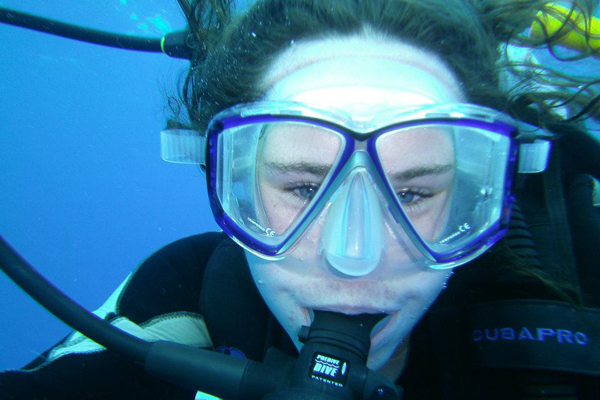An aquatic adventure resurfaces

This story is part of an ongoing series highlighting Northeastern’s research efforts at Mission 31. Full coverage.
Sara Williams first heard about Aquarius when she was in middle school: Girl Scouts of the USA was sending a group of young women to the underwater research habitat for a weeklong ocean science program. Williams, a Girl Scouts member herself, didn’t get to attend but the idea of visiting the habitat stuck with her for more than a decade. It would only be a matter of time before she’d be suiting up and making the trip 63 feet below the surface of the sea to the vessel that has both trained astronauts and inspired budding young scientists like herself.
Williams made her first visit to the habitat in 2012, when she participated in a live-streamed talk with renowned ocean explorer Sylvia Earle. Back then, Williams was still an undergraduate student at the College of William and Mary and had just begun her research with current Northeastern professor Mark Patterson on the coralline gastrovascular system—the network of passageways inside a coral’s body that transport oxygen and nutrients through the animal, acting as both its cardiovascular system and its gut.
Now, as part of Mission 31, a monthlong underwater research dive spearheaded by Fabien Cousteau, grandson of the legendary ocean explorer Jacques Cousteau, Williams is going back to Aquarius and spending even more time with the corals she’s come to love. She has since taken on a full-time position as a research technician in Patterson’s lab at Northeastern’s Marine Science Center and continues to study the way oxygen and nutrients flow through a coral’s body.
Trained in physics, Williams will use an electrical network approach to model that process. “It’s actually quite similar to following an electrical charge through a circuit,” she explained. “Only here the ‘electrical charge’ is oxygen.”
Her plan is to collect data on a series of coral colonies in the reef. She will examine each one for a full 24 hours, measuring both its internal oxygen levels and the acidity of the water nearby. With the help of the aquanauts based at Aquarius for the duration of Mission 31, Williams will also be able to gather information about the photosynthetic activity of the algae living in the coral’s bodies.
The goal of the research project, she said, is to have a good baseline understanding of oxygen dynamics in corals in order to see how they might change under changing climate conditions. “We want to see how their physiology will react to daily environmental stressors on the reef,” she said.
Williams has been researching the same question back in the lab on land for a few years, but Mission 31 now gives her the rare opportunity to look at the organism in its natural environment for long periods of time.





